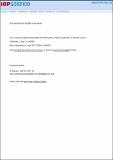Files in this item
A quantum dot single spin meter
Item metadata
| dc.contributor.author | Wabnig, J. | |
| dc.contributor.author | Lovett, B. W. | |
| dc.date.accessioned | 2014-08-21T11:31:00Z | |
| dc.date.available | 2014-08-21T11:31:00Z | |
| dc.date.issued | 2009-04-27 | |
| dc.identifier | 79639611 | |
| dc.identifier | 3bb0e56a-a9df-4a56-a3eb-3a6cf1d30567 | |
| dc.identifier | 000265678400031 | |
| dc.identifier | 66249125360 | |
| dc.identifier.citation | Wabnig , J & Lovett , B W 2009 , ' A quantum dot single spin meter ' , New Journal of Physics , vol. 11 , 043031 . https://doi.org/10.1088/1367-2630/11/4/043031 | en |
| dc.identifier.issn | 1367-2630 | |
| dc.identifier.other | ORCID: /0000-0001-5142-9585/work/47136541 | |
| dc.identifier.uri | https://hdl.handle.net/10023/5211 | |
| dc.description | We thank the QIPIRC (GR/S82176/01) for support. BWL thanks the Royal Society for support through a University Research Fellowship. JW thanks the Wenner-Gren Foundations for financial support. | en |
| dc.description.abstract | We present the theory of a single spin meter consisting of a quantum dot in a magnetic field under microwave irradiation combined with a charge counter. We show that when a current is passed through the dot, a change in the average occupation number occurs if the microwaves are resonant with the on-dot Zeeman splitting. The width of the resonant change is given by the microwave-induced Rabi frequency, making the quantum dot a sensitive probe of the local magnetic field and enabling the detection of the state of a nearby spin. If the dot-spin and the nearby spin have different g-factors, a non-demolition readout of the spin state can be achieved. The conditions for a reliable spin readout are found. | |
| dc.format.extent | 9 | |
| dc.format.extent | 790320 | |
| dc.language.iso | eng | |
| dc.relation.ispartof | New Journal of Physics | en |
| dc.subject | Resonance force microscopy | en |
| dc.subject | Electrical detection | en |
| dc.subject | Carbon nanotube | en |
| dc.subject | Transistor | en |
| dc.subject | QC Physics | en |
| dc.subject.lcc | QC | en |
| dc.title | A quantum dot single spin meter | en |
| dc.type | Journal article | en |
| dc.contributor.institution | University of St Andrews. School of Physics and Astronomy | en |
| dc.contributor.institution | University of St Andrews. Condensed Matter Physics | en |
| dc.identifier.doi | 10.1088/1367-2630/11/4/043031 | |
| dc.description.status | Peer reviewed | en |
This item appears in the following Collection(s)
Items in the St Andrews Research Repository are protected by copyright, with all rights reserved, unless otherwise indicated.

